Failure Analysis of a Pre-Excavation Double Equipment Withdrawal Channel and Its Control Techniques
Abstract
1. Introduction
2. Engineering Background
2.1. Geological Survey
2.2. Project Profile
2.3. Roof Structure Detection
3. Theoretical Analysis
3.1. Analysis of the Stress Field in the Mining Area
3.2. Failure Pattern of the Roadway under Asymmetric Pressure
4. Numerical Simulation
4.1. Evolution Law of Mining-Induced Stress during Final Mining
4.2. Evolution Law of the Plastic Zone during Final Mining
5. Surrounding Rock Control Scheme and Application
5.1. EWC Support Technology during the Final Mining Period
- (1)
- Reinforcement support of anchor cable
- (2)
- Support of buttress hydraulics
5.2. Field Monitoring of the MEWC
- (1)
- Working resistance monitoring of buttress hydraulic supports
- (2)
- Surface displacement of the roadway
6. Discussion
7. Conclusions
- 1
- The extraction of coal leads to a stress superposition of the surrounding rock around the goaf, and the maximum stress concentration coefficient can reach 3~5. Under such a non-uniform stress environment, the plastic zone of the surrounding rock is no longer a circular distribution but gradually evolves into a butterfly shape with the increase of the lateral pressure coefficient. The different cross-section shapes of the roadway do not affect the final plastic zone shape.
- 2
- The stress environment of the MEWC is more complex than that of the AEWC. The stress peak value on the side close to the working face of the MEWC first increases and then decreases, and its distribution features are first asymmetric and then symmetric. Meanwhile, the stress on the side close to the coal pillar is always asymmetrical and the stress value keeps increasing. The stress distribution around the AEWC remains almost unchanged; the value increases only slightly.
- 3
- When the MEWC is not affected by mining, the plastic zone around it is only 1 M and symmetrically distributed. With the advance of the working face, the EWC plastic zone gradually expands and presents an asymmetric distribution. Finally, the plastic zone depth of the MEWC is greater than the length of the supporting body, and the surrounding rock tends to be unstable.
- 4
- After analyzing the damage characteristics of the EWCs during the final mining, the use characteristics of EWCs were further analyzed. The service cycle of the EWCs is short, only about one month. Therefore, we proposed a stability control scheme of the MEWC’s surrounding rock, i.e., the reinforcement technologies of anchor cables and buttress hydraulic supports. After the field application, there was no roof fall or wall caving, and the equipment withdrawal process was successful.
Author Contributions
Funding
Conflicts of Interest
References
- Qian, M.G.; Shi, P.W.; Xu, J.L. Mining Pressure and Strata Control; China University of Mining and Technology Press: Xuzhou, China, 2010. [Google Scholar]
- Wang, B.N. Mechanism of Surrounding Rock Deformation and Failure and Control. Method Research in Retracement Roadway; Xi’an University of Science and Technology: Xi’an, China, 2017. [Google Scholar]
- Ti, Z.Y.; Zhang, F.; Pan, J. Accident analysis of bracket and roof collapse before retracement under high face mining. Chin. J. Geol. Hazard. Control. 2019, 30, 78–83. [Google Scholar] [CrossRef]
- Diederichs, M.S.; Kaiser, P.K. Stability of large excavations in laminated hard rock masses: The voussoir analogue revisited. Int. J. Rock Mech. Min. 1999, 36, 97–117. [Google Scholar] [CrossRef]
- Shabanimashcool, M.; Li, C.C. Vertical stress changes in multi-seam mining under supercritical longwall panels. Int. J. Rock Mech. Min. 2013, 106, 39–47. [Google Scholar] [CrossRef]
- Ren, Y.F.; Ning, Y. Changing Feature of Advancing Abutment Pressure in Shallow Long Wall Working Face. J. China Coal Soc. 2014, 39, 38–42. [Google Scholar] [CrossRef]
- Zhang, W.L.; Qu, X.C.; Li, C.; Wu, Z. Fracture analysis of multi-hard roofs based on microseismic monitoring and control techniques for induced rock burst: A case study. Arab. J. Geosci. 2019, 12, 784. [Google Scholar] [CrossRef]
- Zhang, W.L.; Ma, N.; Ma, J.; Li, C.; Ren, J. Mechanism of Rock Burst Revealed by Numerical Simulation and Energy Calculation. Shock Vib. 2020, 2020, 8862849. [Google Scholar] [CrossRef]
- Cohen, T.; Masri, R.; Durban, D. Analysis of circular hole expansion with generalized yield criteria. Int. J. Solids Struct. 2009, 46, 3643–3650. [Google Scholar] [CrossRef]
- Kang, J.Z.; Shen, W.L.; Bai, J.B.; Yan, S.; Wang, X.Y.; Li, W.F.; Wang, R.F. Influence of abnormal stress under a residual bearing coal pillar on the stability of a mine entry. Int. J. Min. Sci. Technol. 2017, 27, 945–954. [Google Scholar] [CrossRef]
- Yang, R.S.; Zhu, Y.; Li, Y.L.; Li, W.Y.; Lin, H. Coal pillar size design and surrounding rock control techniques in deep longwall entry. Arab. J. Geosci. 2020, 13, 1–14. [Google Scholar] [CrossRef]
- Yang, K.; Gou, P.F. Research on Reasonable Width of Coal Pillars in High Strength Mining Roadway in Wantugou Mine. Geotech. Geol. Eng. 2020, 2020, 1–9. [Google Scholar] [CrossRef]
- Osgoui, R.R.; Unal, E. An empirical method for design of grouted bolts in rock tunnels based on the Geological Strength Index (GSI). Geotech. Geol. Eng. 2009, 107, 154–166. [Google Scholar] [CrossRef]
- Ghabraie, B.; Ren, G.; Zhang, X.Y.; Smith, J. Physical modelling of subsidence from sequential extraction of partially overlapping longwall panels and study of substrata movement characteristics. Int. J. Coal Geol. 2015, 140, 71–83. [Google Scholar] [CrossRef]
- Kang, H.P.; Li, J.Z.; Yang, J.H.; Gao, F.Q. Investigation on the Influence of abutment pressure on the stability of rock bolt reinforced roof strata through physical and numerical modeling. Rock Mech. Rock Eng. 2017, 50, 387–401. [Google Scholar] [CrossRef]
- Li, C.; Zhang, W.L.; Wang, N.; Hao, C. Roof stability control based on plastic zone evolution during mining. J. Min. Saf. Eng. 2019, 36, 753–761. [Google Scholar] [CrossRef]
- Ren, F.Q.; Zhu, C.; He, M.C. Moment tensor analysis of acoustic emissions for cracking mechanisms during schist strain burst. Rock Mech. Rock Eng. 2020, 53, 153–170. [Google Scholar] [CrossRef]
- Ma, N.J.; Li, J.; Zhao, Z.Q. Distribution of the deviatoric stress field and plastic zone in circular roadway surrounding rock. J. China U. Min. Techno. 2015, 44, 206–213. [Google Scholar] [CrossRef]
- Li, J.; Ma, N.J.; Ding, Z.W. Heterogeneous large deformation mechanism based on change of principal stress direction in deep gob side entry and control. J. Min. Saf. Eng. 2018, 35, 670–676. [Google Scholar] [CrossRef]
- Yan, H.; He, F.L.; Yang, T.; Li, L.Y.; Zhang, S.B.; Zhang, J.X. The mechanism of bedding separation in roof strata overlying a roadway within a thick coal seam: A case study from the Pingshuo Coalfield, China. Eng. Fail. Anal. 2015, 62, 75–92. [Google Scholar] [CrossRef]
- Molladavoodi, H.; Rahmati, M. Dilation angle variations in plastic zone around tunnels in rocks-constant or variable dilation parameter. J. Cent. South. Univ. 2018, 25, 2550–2566. [Google Scholar] [CrossRef]
- Wang, W.J.; Dong, E.Y.; Yuan, C. Boundary equation of plastic zone of circular roadway in non-axisymmetric stress and its application. J. China Coal Soc. 2019, 44, 105–114. [Google Scholar] [CrossRef]
- Chen, H.; Jiang, Y.D.; Deng, D.X.; Shao, M.M. Study on deformation characteristics and support optimization of weak surrounding rock in fault zone. J. Min. Sci. Technol. 2018, 3, 543–552. [Google Scholar] [CrossRef]
- Yang, J.; Gao, Y.B.; Liu, S.Q.; Peng, Y.H. Study on failure mechanism and control techniques of the preparation roadway induced by dynamic mining disturbance. J. Min. Sci. Technol. 2018, 3, 451–460. [Google Scholar] [CrossRef]
- Gao, X.C.; Luan, Y.C.; Hu, C.; Lu, W.; Sun, H. Study on bearing mechanism and coupling mechanism of steel arch-concrete composite structure of initial support system of large section tunnel. Geotech. Geol. Eng. 2019, 37, 4877–4887. [Google Scholar] [CrossRef]
- Pan, R.; Wang, Q.; Jiang, B.; Li, S.C. Model test on failure and control mechanism of surrounding rocks in tunnels with super large sections. Arab. J. Geosci. 2019, 12, 1–17. [Google Scholar] [CrossRef]
- Yang, H.Z.; Guo, Z.; Chen, D.; Wang, C.; Zhang, F.; Du, Z. Study on Reasonable Roadway Position of Working Face under Strip Coal Pillar in Rock Burst Mine. Shock Vib. 2020, 2020, 8832791. [Google Scholar] [CrossRef]
- Pellet, F.; Roosefid, M.; Deleruyelle, F. On the 3D numerical modelling of the time-dependent development of the damage zone around underground galleries during and after excavation. Tunn. Undergr. Sp. Tech. 2009, 24, 665–674. [Google Scholar] [CrossRef]
- Bai, Q.X.; Tu, S.H.; Wang, F.T. Field and numerical investigations of gateroad system failure induced by hard roofs in a longwall top coal caving face. Int. J. Coal Geol. 2017, 173, 176–199. [Google Scholar] [CrossRef]
- Jiang, L.S.; Wang, P.; Zhang, P.P. Numerical analysis of the effects induced by normal faults and dip angles on rock bursts. C. R. Mec. 2019, 345, 690–705. [Google Scholar] [CrossRef]
- Jia, H.S.; Wang, L.Y.; Fan, K.; Peng, B.; Pan, K. Control technology of soft rock floor in mining roadway with coal pillar protection: A case study. Energies 2019, 12, 3009. [Google Scholar] [CrossRef]
- Li, A.; Liu, Y.; Dai, F.; Liu, K.; Wei, M.D. Continuum analysis of the structurally controlled displacements for large-scale underground caverns in bedded rock masses. Tunn. Undergr. Sp. Tech. 2020, 97, 103288. [Google Scholar] [CrossRef]
- Yang, G.R. Study on the Roof Caving Prediction Principle and Method of the Hazard. Area at Starting Cut Lijiahao Mine; China University of Mining and Technology (Beijing): Beijing, China, 2013. [Google Scholar]
- Kaiser, P.K.; Yazici, S.; Maloney, S. Mining-induced stress change and consequences of stress path on excavation stability—A case study. Int. J. Rock Mech. Min. 2001, 38, 167–180. [Google Scholar] [CrossRef]
- Rezaei, M.; Hossaini, M.F.; Majdi, A. Development of a time-dependent energy model to calculate the mining-induced stress over gates and pillars. J. Rock. Mech. Geotech. 2015, 7, 306–317. [Google Scholar] [CrossRef]
- Zhao, Z.Q. Mechanism of Surrounding Rock Deformation and Failure and Control. Method Research in Large Deformation Mining Roadway; China University of Mining and Technology (Beijing): Beijing, China, 2014. [Google Scholar]
- Zhao, Z.Q.; Ma, N.J.; Liu, H.; Guo, X.F. A butterfly failure theory of rock mass around roadway and its application prospect. J. China Univ. Min. Technol. 2018, 47. [Google Scholar] [CrossRef]
- Guo, X.F.; Zhao, Z.Q.; Gao, X.; Wu, X.Y.; Ma, N.J. Analytical solutions for characteristic radii of circular roadway surrounding rock plastic zone and their application. Int. J. Min. Sci. Technol. 2019, 29, 263–272. [Google Scholar] [CrossRef]
- Liang, P.; Gao, Y.T. Numerical investigation on cracking behavior of granite with intersecting two-flaws: A flat-joint modeling method. Lat. Am. J. Solids Struct. 2020, 17, 1–14. [Google Scholar] [CrossRef]
- Liu, J. In-situ stress measurements and study on distribution characteristics of stress fields in underground coal mines in yitai mining area. J. China Coal Soc. 2011, 36, 562–566. [Google Scholar] [CrossRef]
- Jia, H.S.; Ma, N.J.; Zhu, K. Mechanism and control method of roof fall resulted from butterfly plastic zone penetration. J. China Coal Soc. 2016, 41, 1384–1392. [Google Scholar] [CrossRef]
- Lin, C.D.; Lu, S.L.; Shi, Y.W. Study on supporting effect of soft roof bolt in coal roadway. J. China Coal Soc. 2000, 25, 482–485. [Google Scholar] [CrossRef]
- Li, C.; Wu, Z.; Zhang, W.L.; Sun, Y.H.; Zhu, C.; Zhang, X.H. A case study on asymmetric deformation mechanism of the reserved roadway under mining influences and its control techniques. Geomech. Eng. 2020, 22, 449–460. [Google Scholar] [CrossRef]

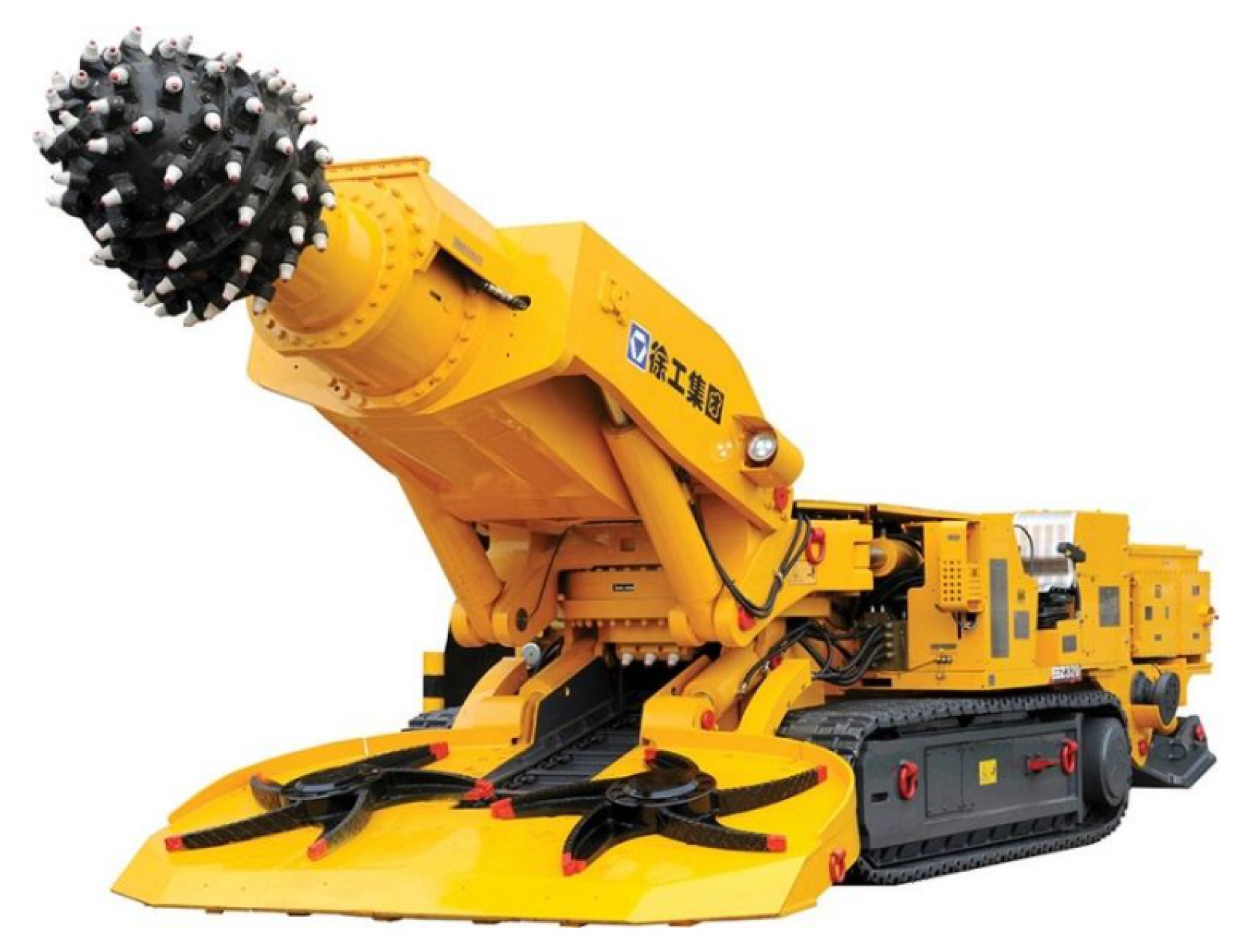

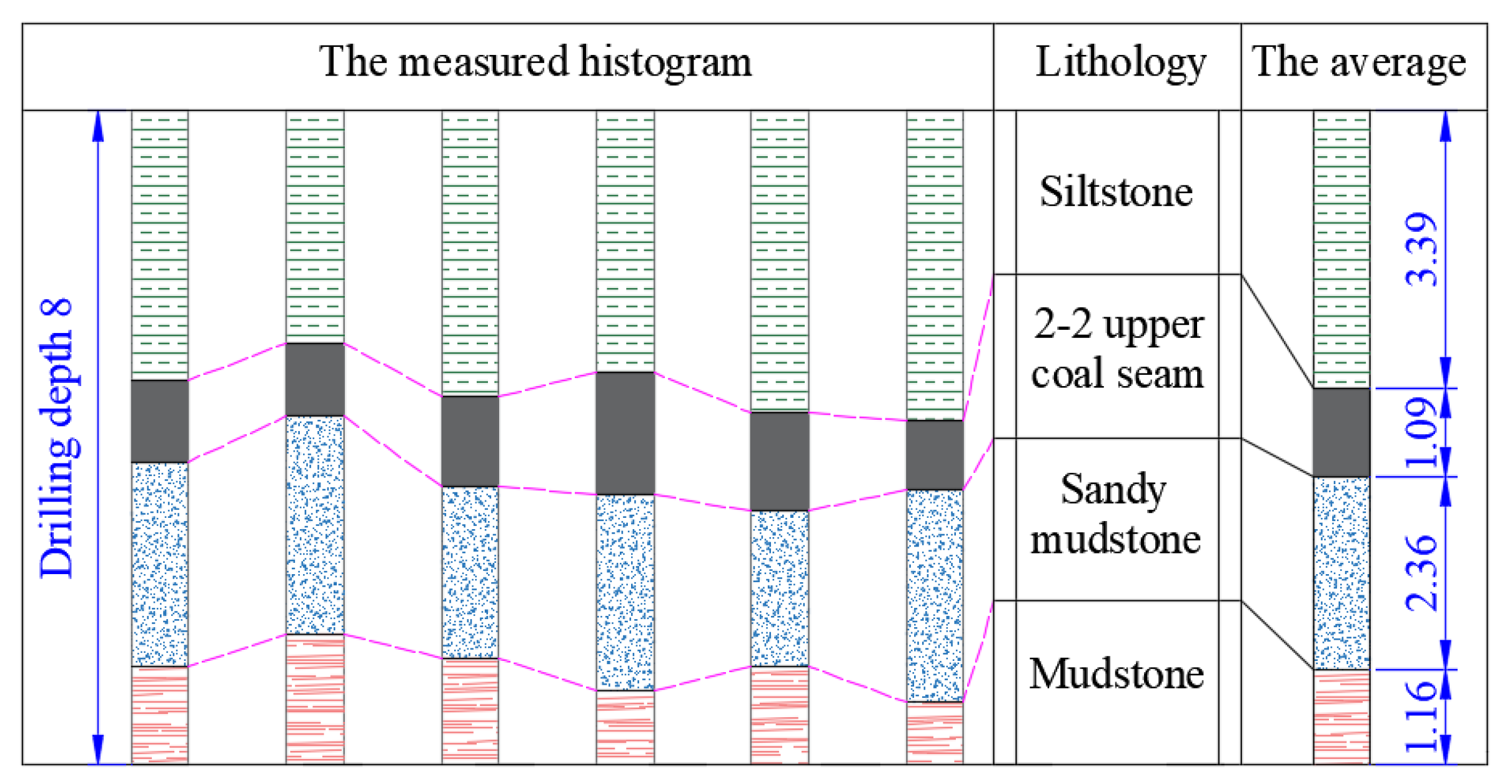

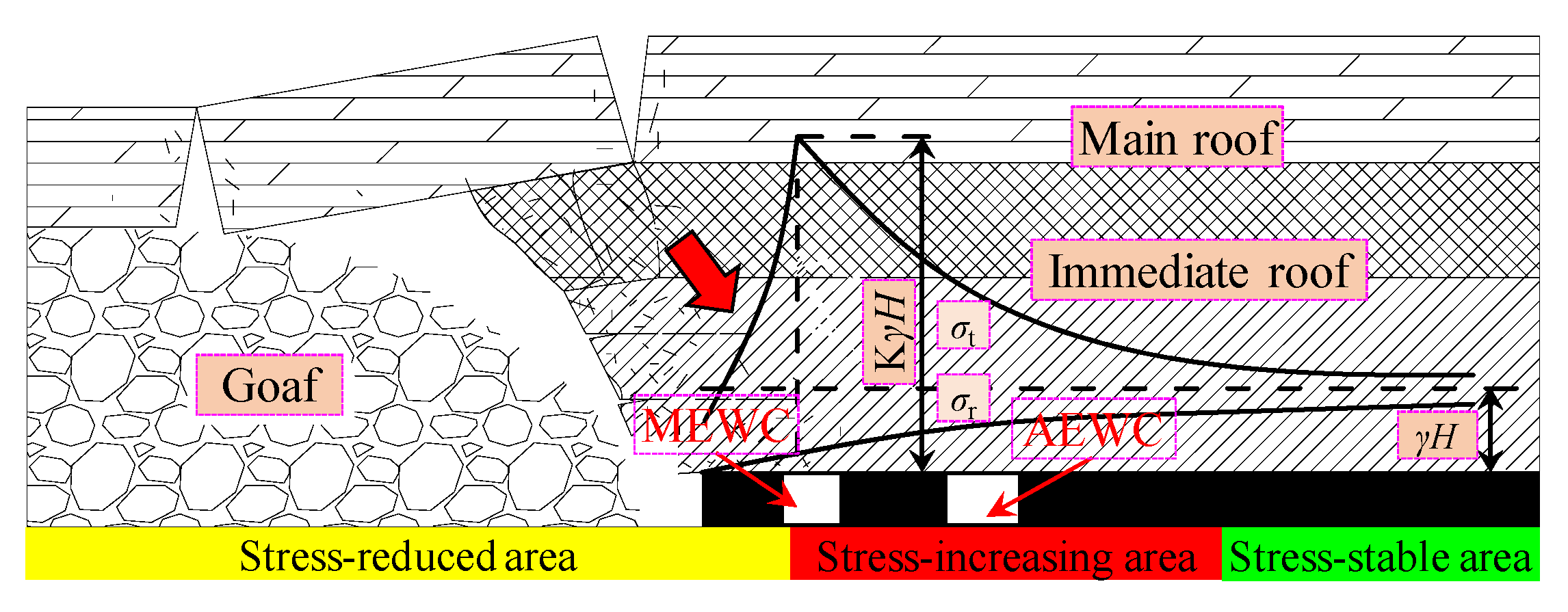

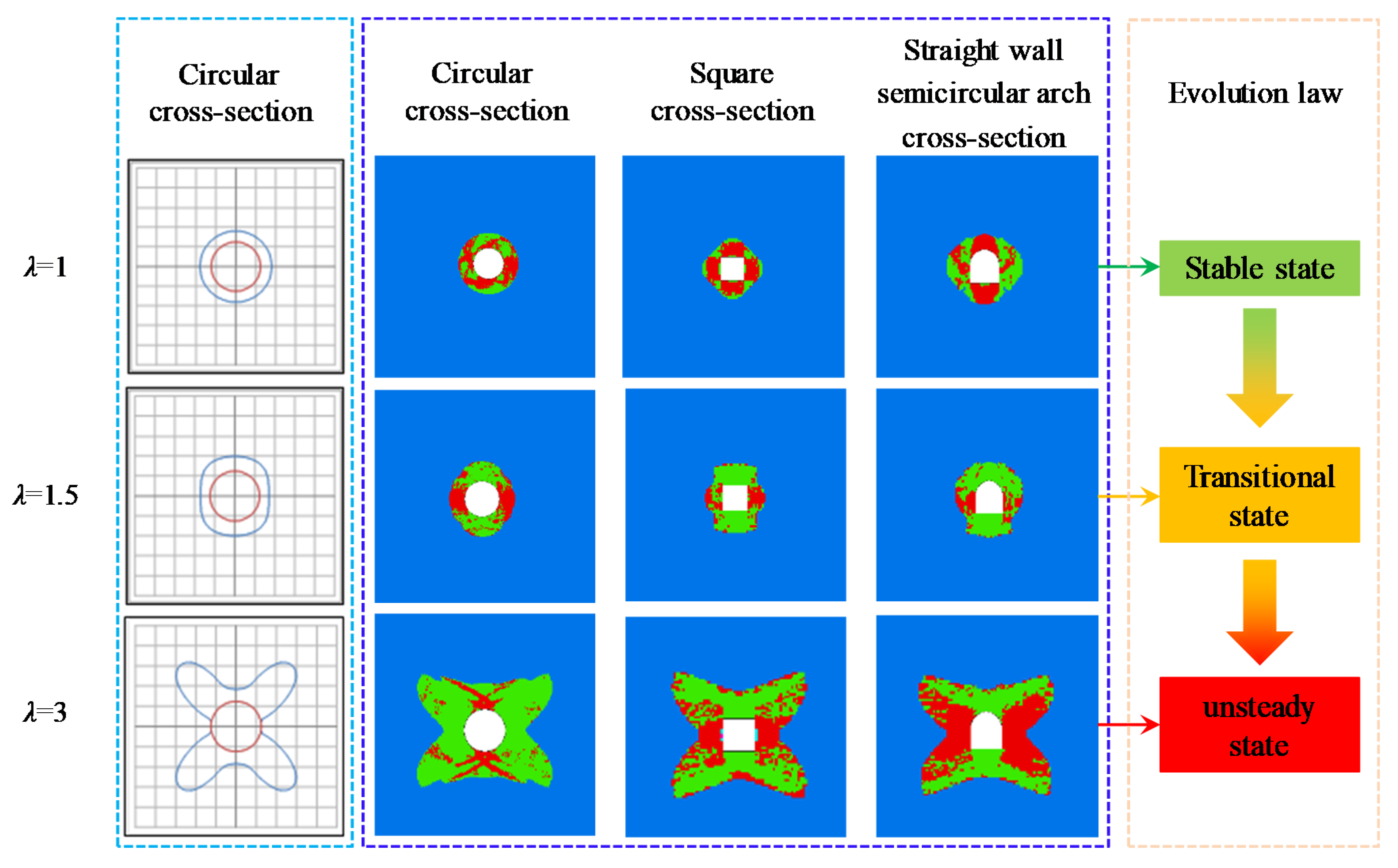

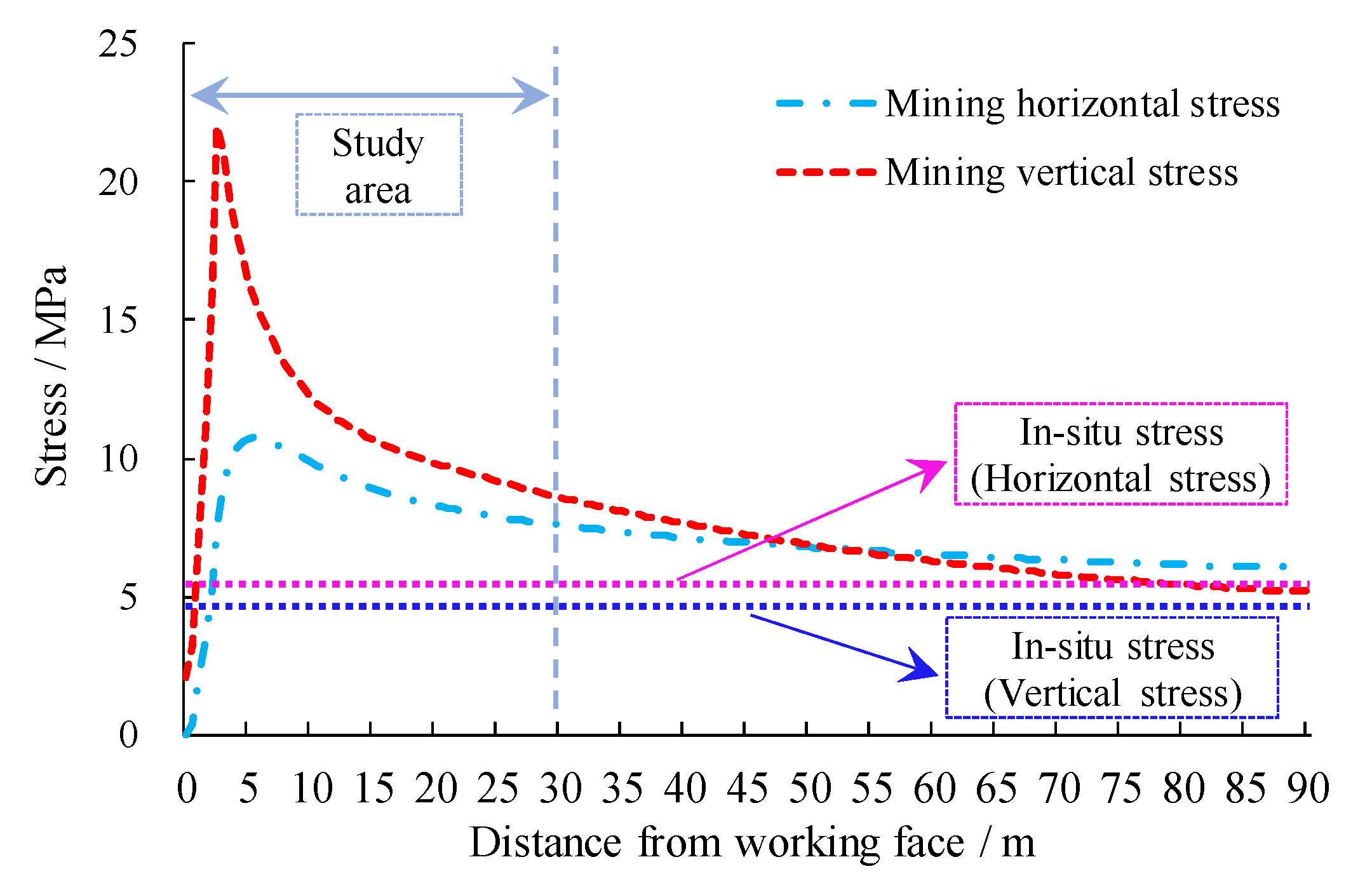


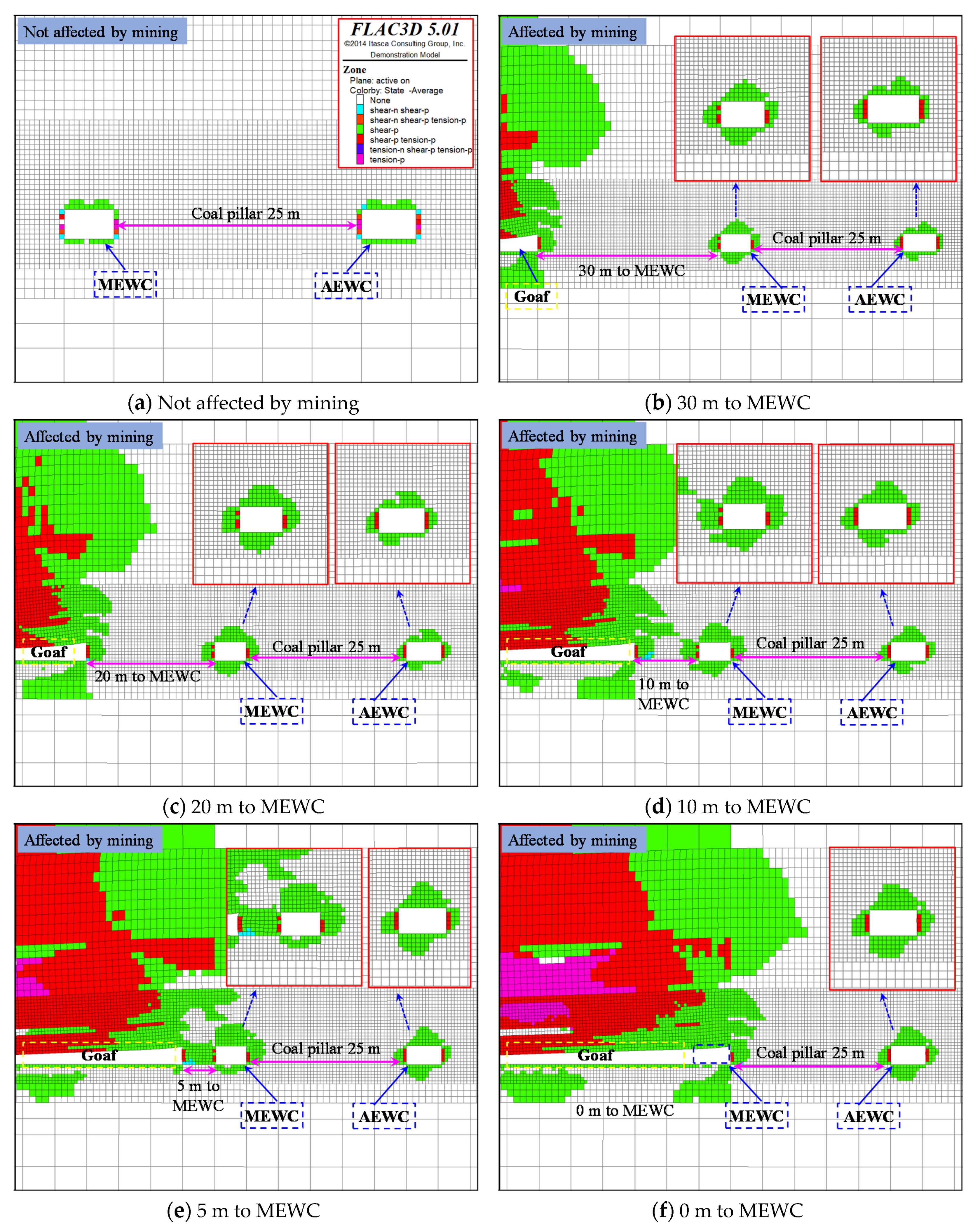

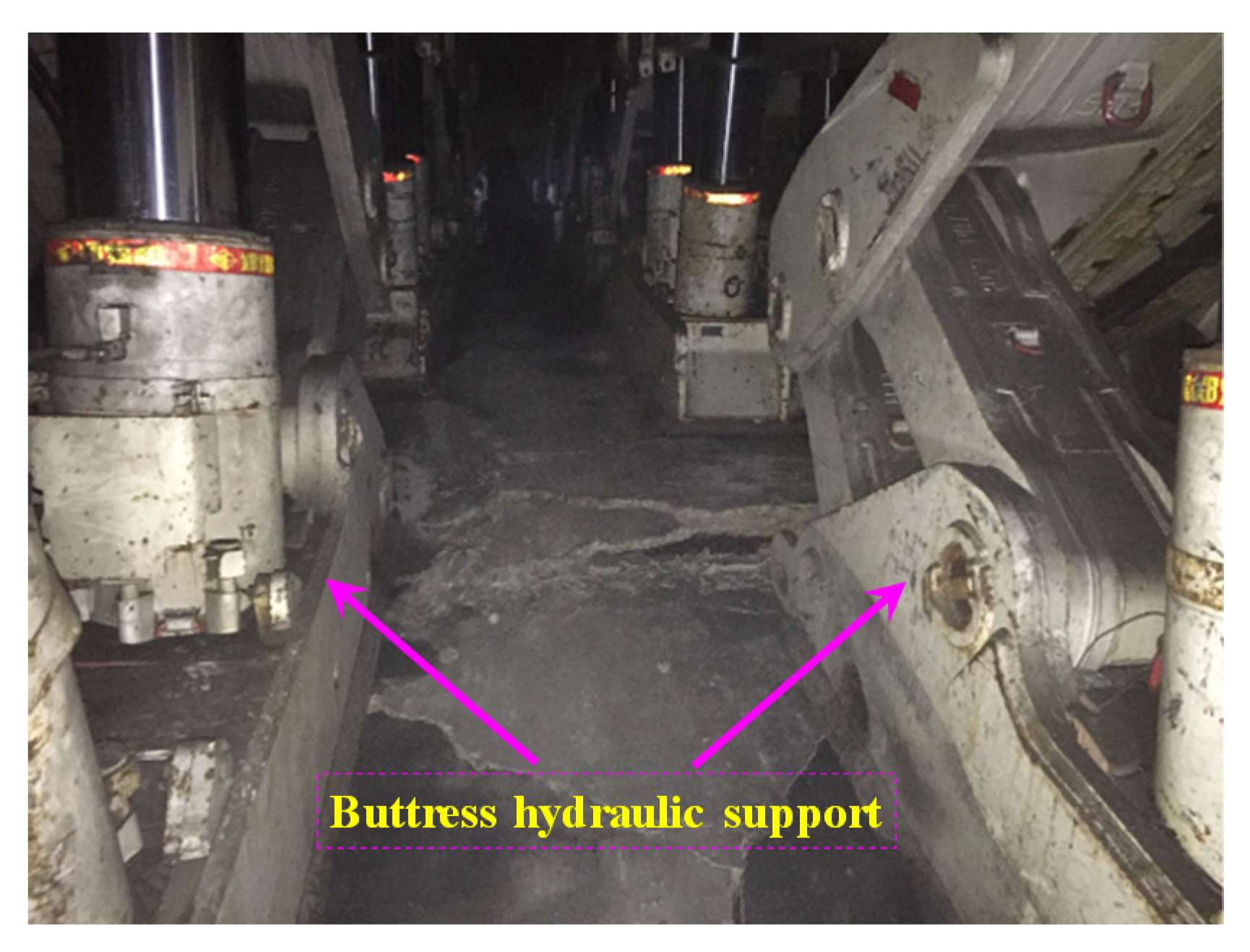

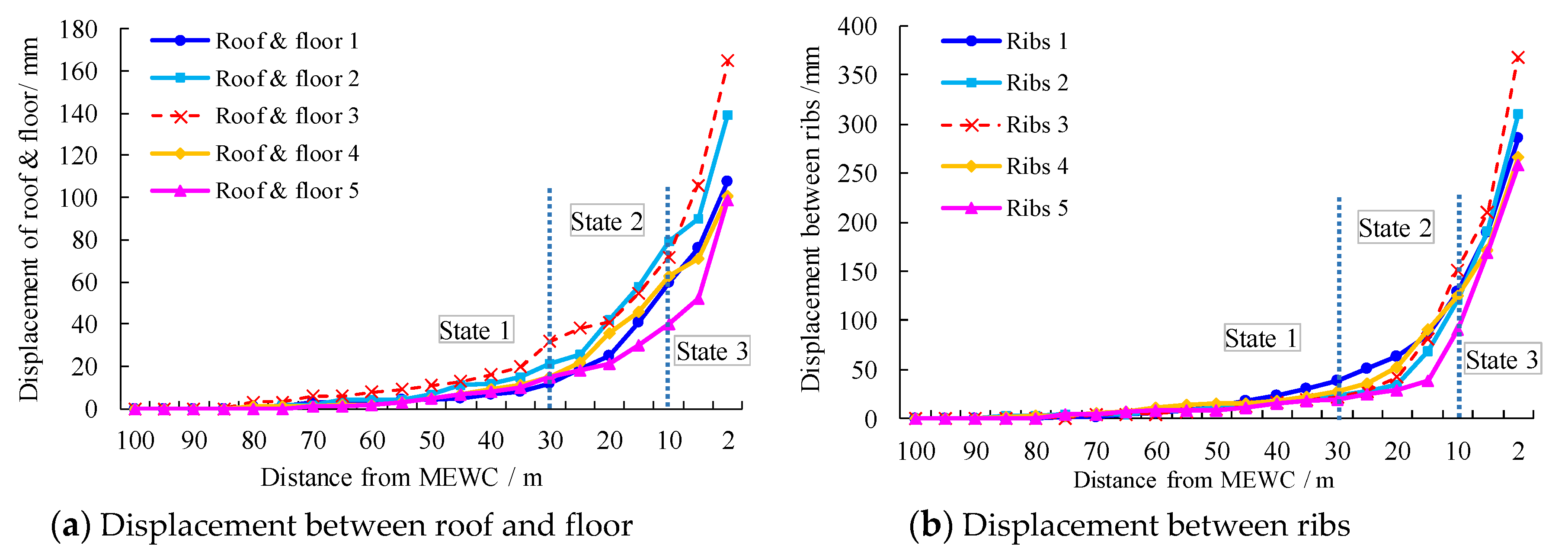


| Lithology | Density (kg/m 3) | Bulk Modulus /103 MPa | Shear Modulus /10 3 MPa | Friction Angle/(°) | Cohesion /MPa | Tensile Strength/MPa |
|---|---|---|---|---|---|---|
| Fuyan | 2500 | 3.18 | 1.6 | 32 | 2.21 | 1.22 |
| Sandy-mudstone 5 | 2400 | 3.68 | 1.8 | 35 | 2.63 | 1.13 |
| Siltstone 2 | 2600 | 2.92 | 1.9 | 31 | 1.52 | 1.08 |
| Fine-sandstone 3 | 2500 | 2.52 | 1.7 | 34 | 2.53 | 1.17 |
| Siltstone 1 | 2600 | 3.91 | 1.9 | 30 | 1.94 | 1.13 |
| 2-2 upper-coal | 1400 | 1.89 | 0.6 | 25 | 1.56 | 0.93 |
| Sandy-mudstone 4 | 2200 | 2.76 | 1.6 | 32 | 1.72 | 1.26 |
| Mudstone | 2300 | 1.76 | 0.8 | 27 | 1.44 | 0.86 |
| 2-2 middle-coal | 1500 | 1.89 | 0.6 | 25 | 1.52 | 0.93 |
| Sandy-mudstone 3 | 2400 | 3.81 | 2.2 | 30 | 1.83 | 1.02 |
| Fine-sandstone 2 | 2400 | 3.66 | 1.8 | 28 | 1.76 | 1.15 |
| Sandy-mudstone 2 | 2500 | 2.53 | 2.7 | 32 | 2.11 | 1.21 |
| Fine-sandstone 1 | 2400 | 3.68 | 1.8 | 31 | 1.92 | 1.12 |
| Sandy-mudstone 1 | 2500 | 2.53 | 1.7 | 33 | 2.52 | 1.06 |
Publisher’s Note: MDPI stays neutral with regard to jurisdictional claims in published maps and institutional affiliations. |
© 2020 by the authors. Licensee MDPI, Basel, Switzerland. This article is an open access article distributed under the terms and conditions of the Creative Commons Attribution (CC BY) license (http://creativecommons.org/licenses/by/4.0/).
Share and Cite
Li, C.; Guo, X.; Lian, X.; Ma, N. Failure Analysis of a Pre-Excavation Double Equipment Withdrawal Channel and Its Control Techniques. Energies 2020, 13, 6368. https://doi.org/10.3390/en13236368
Li C, Guo X, Lian X, Ma N. Failure Analysis of a Pre-Excavation Double Equipment Withdrawal Channel and Its Control Techniques. Energies. 2020; 13(23):6368. https://doi.org/10.3390/en13236368
Chicago/Turabian StyleLi, Chen, Xiaofei Guo, Xiaoyong Lian, and Nianjie Ma. 2020. "Failure Analysis of a Pre-Excavation Double Equipment Withdrawal Channel and Its Control Techniques" Energies 13, no. 23: 6368. https://doi.org/10.3390/en13236368
APA StyleLi, C., Guo, X., Lian, X., & Ma, N. (2020). Failure Analysis of a Pre-Excavation Double Equipment Withdrawal Channel and Its Control Techniques. Energies, 13(23), 6368. https://doi.org/10.3390/en13236368




